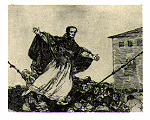
Criticism of the political role
of the Church after the War
of Independence







Goya openly criticised the participation of a sizeable part of the Church in the anti-liberal repression unleashed by Fernando VII's party Be careful, the rope is breaking down (Desastres de la Guerra) |
In the Disasters of War and in other drawings in the years 1815-20, Goya openly criticised the participation of a sizeable part of the Church in the anti-liberal repression unleashed by Fernando VII's party.
These works are a faithful reflection of the socio-political context of the times. The War of Independence had suddenly awakened the political demons of the age that had been slumbering until then. Throughout the conflict a large part of the aristocracy, the clergy and the anti-bourgeois peasantry entered into tacit alliances to rid the country of the French and their Spanish collaborators. One result of the political schizophrenia that riddled the country was that the radicals accused those who were in favour of liberalization of the country, those who wanted to make Spain comparable to England or France, of being afrancesados[1] In Disaster no. 77, Goya uses the symbol of a tightrope-walking bishop (in the preparatory drawing,the tightrope walker was portrayed as the Pope) as a metaphor for the sad, difficult and at times risible balancing act that the Church engaged in in order to maintain its temporal power through the revolutionary storms that raged in Europe. In the defence of its privileges one sector of the Church betrayed its own principles by openly supporting the cruel reppression unleashed against the liberal party. Goya depicts this collaboration in drawing no. 51 from Album C. In the picture two friars flank a woman being tortured. Another example is drawing no. 51, where a cleric uses a crucifix to menace and terrify a prisoner who is being interrogated. The wave of absolutist repression was given greater force by the composition of the party that surrounded Fernando VII, made up largely of the clergy. This party was supported throughout the country by all the social classes. Goya spoke out against them in the Disasters by depicting them as whisperers and birds of ill-omen in the form of ugly birds of prey (DW 89, DW92, DW97), wolves (DS74) and even vampires (DW90) The spectacular Disaster no. 91 summarises his thinking on the subject. In The results Goya shows an exhausted woman, a metaphor of Spain's condition after the war, who is being attacked and torn apart by a flock of ghastly birds of prey. In this print, Goya prophesied the future of Spain for the next 100 years See also:
Notes(1) The afrancesados (literally 'frenchified') were members of the Spanish aristocracy and bourgoisie who were influenced by French thought, politics, fashion, etc. The term became perjorative after the French invasion of 1808, and to be called afrancesado during the repression of Fernando VII's time was tantamount to an order of exile or worse.BibliographyAlcalá Flecha, Roberto. Literatura e ideología en el arte de Goya. Zaragoza: Diputación General de Aragón, 1988. Francisco Javier García Marco |
 |
InfoGoya 96 is an initiative of the University of Zaragoza, sponsored by the Institution Fernando el Católico of the Deputation of Zaragoza on an Apple Internet Server donated by Apple Computer. |    |